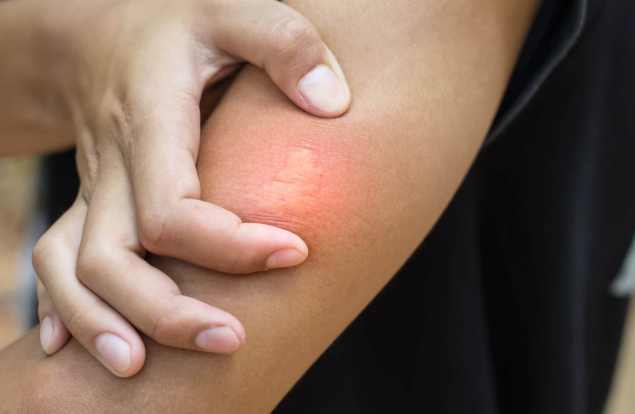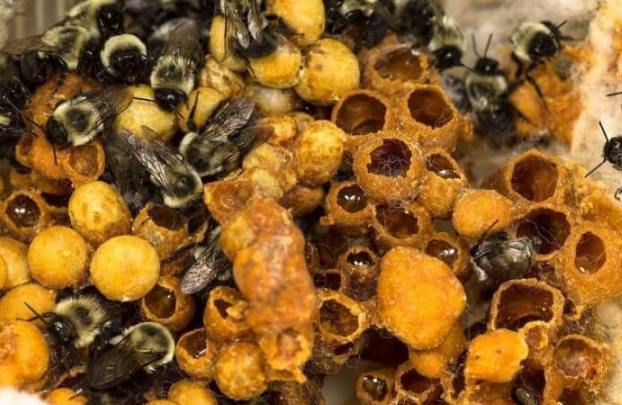The short answer? Yes, bumblebees do sting. But, it’s rare.
The Long Answer: Do Bumblebees Sting?
Drones or male bumblebees don’t sting. Because they do not have stingers.
Female bees sting. But, only if they feel threatened or they believe their hive is at risk.
Also, they normally warn you if they’re going to sting you. They do this by sticking up their middle leg.
If a Bumblebee Stings You, What Do You Do?

Usual reactions to bumblebee stings are swelling, redness, and itching.
However, in rare cases, people may also experience:
1) Allergic reactions (Level 1: Redness, itching, and swelling; Level 2: Above symptoms + intestinal problems like diarrhea or vomiting; Level 3: Either of the above symptoms + difficulties in breathing; Level 4: Either of the above symptoms + fainting, anaphylactic shock, and heart palpitations)
2) Cross reactions (Once you’ve experienced an allergic reaction to bumblebee stings, it’s likely you’ll experience an allergy to honeybee stings as well), or
3) Toxic reactions (These kinds of reactions will only happen if stung dozens of times in a short period of time).
P.S: Medicines can actually strengthen allergic reactions. If you’ve got an increased risk of being stung by a bee, avoid using aspirin or beta-blockers.
So, How Can You Avoid Bumblebee Stings?
- Don’t disturb bumblebees
- Try not to bump hives
- Do not hit a bumblebee flying around you
- Try to stay away from perfumed smells
- Don’t let people with known bee venom allergies into your greenhouse
How Can You Treat Bumblebee Stings?
Most bumblebee reactions are treated using adrenaline, corticosteroids, or antihistamines.
Panic can make things worse. After a bee has stung you, try to remain calm, and get access to the nearest medical facility as soon as you can.
Some important things to be noted:
- Try to avoid physical efforts and alcoholic drinks after being stung.
- A desensitization cure is possible. Your body can be made better accustomed to bumblebee stings via immunotherapy.
- Carry adrenaline injection ampoules or an adrenaline-injector in case of emergencies.
When Do Bumblebee Stings Need Medical Attention?
If you’re experiencing nausea, dizziness, stomach cramps, weakness, or skin rashes, do contact 911 or the nearest hospital.
Upon not receiving immediate medical attention, you may experience difficulties in breathing, a drop in blood pressure, and a loss of consciousness.
Treatment of severe allergic reactions is possible with intravenous antihistamines, oxygen, and other medications.
Difference Between Honeybee and Bumblebee Stings
There are 3 major differences between the two:
- Unlike honeybees, bumblebees can sting you multiple times.
- Bumblebee stingers do not have barbs, as opposed to honeybee stingers (which is how they can remove their stingers and sting multiple times).
- Honeybees die after stinging just once, but do bumblebees die after they sting? Nope.
Basically, bumblebee stings are smooth. It feels like a needle, and doesn’t get caught in your skin. Whereas when it comes to honeybees, since they have barbs on their surface, the sting gets caught in the skin. This means they literally need to tear out their abdomen during the stinging process, which causes death.
What are some home remedies for bee stings? You can try the following:
- Ice the stung area. This will reduce venom absorption.
- Apply a small amount of honey to the affected area.
- Apply a paste made of water and baking soda.
- Soak a bandage in apple cider vinegar and then apply this bandage to the stung area.
- Dab a bit of toothpaste on the affected area.
- Apply aspirin paste or wet aspirin.
- Use herbs and oils.
Read here for detail – Treat a Bee Sting at Home
So, What Are the Odds Of Death by Bee Stings?
Actually, in the USA, there’s an increased possibility of death by lighting than by bee stings! This is true because, in the year 2000, only 54 people died because of bee stings (from a population of 281 million people according to Census data)
Apparently, Bee Stings Might Be Good for You
It’s true!
According to two studies, it has been observed that mice that developed an allergic reaction to honey bee venom are more likely to survive stronger, more dangerous doses of the same honey bee venom later on.
Scientists observed that humans tend to get rid of diseases in two ways. One, is “type 1”. This reaction responds to toxins and viruses by destroying them. The “type 2” on the other hand uses symptoms like sneezing and coughing to get rid of those diseases.
The type 2 response improves the body’s immunity. This is because it produces the antibody immunoglobulin E (IgE), which is closely associated with resistance to worm infections.
However, another scientist believed that the type 2 responses had a bad rap. To explore this further, he exposed 2 strains of mice to honey bee venom; one was a type 1 response-prone strain and the other was a type 2 response-prone strain. Both these control groups were given no injections.
Once both mice were stung, they both showed a type 2 reaction. (coughing, sneezing, wheezing). This clearly ramped up their immunity because after 3 weeks, they were administered a more lethal dose, and the mice were protected!
It was observed that 86% of mice that had an allergic reaction survived the honey bee sting, vs. 7% of the mice that were not allergic who died from the dose.
Goes to show that honeybee stings produce antibodies that make you stronger. Food for thought, huh?
Bumblebees In Your Garden? Try These Remedies

If you’re worried about being stung, there are a few things you can do to free your garden from the unwanted presence of bumble bees:
- Cut down on habitat space
- Clear away grass and brush piles
- Keep the ground watered
- Clean your trash cans regularly
P.S: It’s a myth that getting rid of flowers will help. Bumblebees can build nests several miles away from these flowers and pollinate nevertheless.
Now that you’re familiar with bumblebee stings, here are some other bumblebee characteristics you might not be familiar with.
1. Bumblebees Are Good Pollinators
Did you know that bumblebees are better pollinators than honeybees?
Crops like cucumbers, strawberries, blueberries, melons, and raspberries are well suited to pollination by bumblebees.
It’s the female bee who looks after the collection of pollen and nectar.
Through a service called “buzz pollination”, they loosen the trapped pollen from plants with the help of their jaws. These female bees then carry this pollen back to the nest, on their rear legs.
2. Bumblebees Fly Back and Forth
Yup! Rather than up and down, they fly back and forth.
And since bumblebees have tiny wings, it keeps them aloft.
Learn more about how bumblebees fly here.
3. Bumblebees Honey
Do bumblebees make honey? Well, similar to honeybees, bumblebees too make honey. (actually, less than 5% of bumblebees make honey)
Of course, it’s not enough to be consumed by humans.
4. Bumblebees Are Social!
Bees live together in colonies. Each colony could contain 50 to 100 people, as per insights by the National Wildlife Federation.
Bees could be more social than us. Wow.
However, there are solitary bees too. These live in individual nests that are tunneled in tree trunks or the soil.
5. Bumblebees Are Considered To Be Endangered
The last recorded sighting of the rusty patched bumblebee in New Hampshire was in 1993!
This proves that bumblebees are on a decline. Probably due to pesticides, parasites, or poor nutrition.